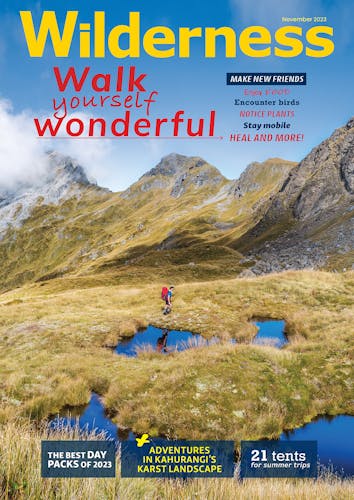No matter how much effort we put into planning a wilderness trip, circumstances can conspire against us. But a willingness to adapt can sometimes lead to a satisfying and successful outcome. By Louise King
Even the most meticulous of plans can be thwarted. Rather than sticking doggedly to one goal, part of the planning process should involve a consideration of the ‘what ifs’. This means having not only your holy grail Plan A, but also one or more contingency plans to avoid disappointment and potential disaster and enable a fulfilling, safe adventure.
Take a recent trip of ours to Arthur’s Pass. We live in Auckland, and tramping visits to the South Island are a rare and treasured occurrence. For this particular trip, we had drawn up separate wish lists for day and overnight tramps. I had seen photos of Barker Hut, sitting like an isolated beacon, surrounded by imposing tops, its reflection mirrored in a nearby tarn. However, I was also aware that several days of reasonable weather would be needed to avoid becoming stranded by the Waimakariri River if its waters rose.
As our trip approached, bands of heavy rain headed towards Arthur’s Pass. Sunny weather was cruelly forecast on either side of our allotted time. However, we had discussed alternative plans and were not despondent, nor was there a need to press ahead with Plan A on the off chance that all would be well. Rather than treating the weather as an enemy, we worked with it.
Heavy rain was forecast when we arrived in Arthur’s Pass. Our choice was obvious – a quick wander around Castle Hill followed by an afternoon hike to Bealey Spur Hut. Lying east of Arthur’s Pass, Bealey Spur is sheltered from north-westerlies. Its slope is more gradual than others in the area, yet it’s high enough for expansive views. It’s an ideal introduction to the area. The best of the weather was due over the next two days, so we camped beside tarns on the Kelly Range and were treated to a sublime sunset.
We finished our time in Arthur’s Pass by completing the Casey–Binser route, which is less affected by rain than other routes such as Mingha–Deception and Edwards–Hawdon. As it’s a circuit with no shuttle required, it was even more convenient than those other two options.
The trip was memorable for all the right reasons, although I am not advocating avoiding challenges. Some of the best experiences come from pushing past obstacles to experience the ecstasy of achievement. But this can also lead to those ‘getting away with it’ moments.
I have had my share of near-misses. In one unforgettable winter incident on Ben Nevis in Scotland, having decided to push on and complete a second ice climb, we summited in the dark. Our group of four then over-compensated with our pacing and compass bearing to avoid the edge of a corrie (mountainside hollow), ending up near the top of the notorious Five Finger Gully at 10pm in blizzard conditions. We were cold and wet, with no food and not enough headlamps between us. Luckily, we made fortunate decisions and were back at our car by midnight, but that was certainly a valuable learning experience.
As we know, accidents often occur as a result of a number of poor decisions. There are various metacognitive influences over our decision-making process. These have been considered in detail by the excellent series of articles on heuristics published in Wilderness this year. Arguably the biggest decision is whether or not to set off on the planned route. Perhaps we are familiar with the route and a bit complacent, or we may be worried that we won’t get another chance. We might see other people attempting it and therefore believe we can too, or perhaps we undertake a route because someone more experienced says it’s doable.
The awareness of such influences should be considered in the planning process, as well as factors such as experience, weather conditions, equipment, fitness and fatigue. Not considering these can lead to negative and even tragic consequences.
One example of this is the tragedy on Taranaki Maunga in July 1953 in which six people – five nurses and a guide – died.
The inexperienced group was large – 30 members of the Nurses’ Tramping Club and the Taranaki Alpine Club – and had two guides. They left Tahurangi Hut after 11am, too late for the short winter’s day. Conditions were icy rather than soft, leading to slower progress because of step cutting. When they left the summit at 3.30pm, the temperature was dropping rapidly. They split into three smaller groups, but these were still too large to be managed in such conditions. The group of seven involved in the ensuing accident were all on one rope and slid over a bluff together, their guide unsuccessfully trying to anchor them. No one else in the group had an ice axe.
History has a tragic tendency to repeat itself. In researching this incident, I came across details of another fatal accident on Taranaki in 2013 that had similarities to the 1953 tragedy: a large group with a range of experience, unclear leadership, fatigue, ignoring time and weather constraints and ill-equipped.
Only the most complacent or naïve believe they are above making misjudgements. Nevertheless, analysing incidents such as these, as well as learning from your own mishaps, should help to avoid similar situations. By contingency planning and informed decision-making, you are more likely to avoid miserable and potentially dangerous situations.
Barker Hut is still on my ‘to do’ list, but it’s all good.
– Louise King is a former outdoor instructor and a teacher in Auckland.







